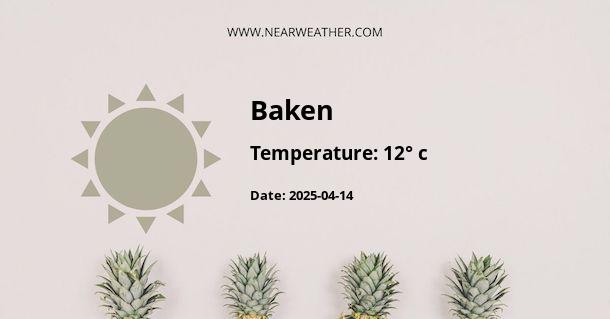Understanding Baken, DE Climate and Weather Patterns
Baken, Delaware, positioned in the Mid-Atlantic region of the United States, is subject to a modulating climate that ranges from warm, humid summers to chillier winters. This combination results in a humid subtropical climate classification, with significant variation based on proximity to the Atlantic coast and the Delaware Bay. We will explore the nuances of Baken's climate, examining seasonal variations, precipitation patterns, and weather phenomena that define this location.
Seasonal Weather Patterns in Baken, DE
Spring
Spring in Baken is characterized by a rapid warming trend, with temperatures commonly ranging from cool to comfortably warm. During this transitional season, flora begins to bloom, indicative of the fertile conditions.
| Month | Average High (°F) | Average Low (°F) | Average Precipitation (inches) |
|---|---|---|---|
| March | 55 | 35 | 4.17 |
| April | 65 | 44 | 3.49 |
| May | 74 | 54 | 4.09 |
Summer
Summertime is when Baken experiences its peak in temperatures and tourist activities. High humidity levels and extended periods of sunshine are common throughout these months. The weather is conducive to beach-going and outdoor events.
The Atlantic's influence moderates temperatures, often creating a pleasant sea breeze that can provide relief during the hottest days.
| Month | Average High (°F) | Average Low (°F) | Average Precipitation (inches) |
|---|---|---|---|
| June | 83 | 63 | 4.30 |
| July | 87 | 68 | 4.62 |
| August | 85 | 67 | 3.82 |
Fall
Autumn in Baken marks the transition from the humid summer to the cooler winter. This season is often noted for its colorful foliage and the waning of summer tourism. It's an ideal time for outdoor activities as the humidity drops and temperatures become more crisp.
| Month | Average High (°F) | Average Low (°F) | Average Precipitation (inches) |
|---|---|---|---|
| September | 78 | 60 | 4.27 |
| October | 67 | 48 | 3.58 |
| November | 56 | 38 | 3.16 |
Winter
Winter months bring colder temperatures and the possibility of snow, with January often being the coldest month. Even with the chilly weather, outdoor activities like bird-watching and winter sports are common in the region's natural settings.
| Month | Average High (°F) | Average Low (°F) | Average Precipitation (inches) | Average Snowfall (inches) |
|---|---|---|---|---|
| December | 48 | 31 | 3.94 | 1.0 |
| January | 43 | 27 | 3.03 | 4.5 |
| February | 45 | 28 | 2.74 | 6.3 |
Precipitation and Extreme Weather Events
Baken's average annual precipitation amounts to approximately 45 inches, and snowfall accumulation varies, with the average being around 12 inches per year. The region is also vulnerable to severe weather phenomena, including nor'easters, tropical storms, and occasionally, hurricanes.
Hurricanes and Tropical Storms
Although hurricanes and tropical storms do not frequently make direct landfall in this area, their impact can bring heavy rains, flooding, and strong winds, disrupting the community and ecosystem. Residents are always urged to monitor the Atlantic hurricane season closely, which typically extends from June to November.
Nor'easters
Characteristically, nor'easters affect the area during fall, winter, and early spring. These powerful storms can bring substantial rainfall, snowfall, and gale-force winds, often resulting in coastal erosion and property damage.
- Preparation for such events includes reinforcing structures and having emergency supplies on hand.
- Evacuation plans are sometimes necessary, particularly for areas near the water that are at higher risk for storm surge.
Comparative Climate Data for Baken, DE and Other Localities
When assessing Baken's climate relative to places further inland such as Dover, DE, or coastal areas like Rehoboth Beach, DE, one can observe slight variations. Baken's proximity to water tends to moderate its temperature extremes compared to locations that are further inland.
- In terms of temperatures, coastal regions may have cooler summers and milder winters than their inland counterparts.
- Precipitation is generally ample throughout the state, but Baken might experience more severe weather impacts being closer to the coast.
Climate Change Implications
Like many regions around the globe, Baken is not immune to the effects of climate change. Rising sea levels, increased incidence of extreme weather events, and temperature shifts are part of ongoing environmental concerns. Steps toward sustainability and resilience are integral to managing future climate-related challenges.
Expert opinion suggests that increased coastal protections, infrastructural updates, and community planning with climate adaptation in mind are pivotal to sustaining Baken's environmental and economic health.
Resiliency Planning
- Improving water management systems to deal with heavy precipitation and prevent flooding.
- Investing in green infrastructure to enhance natural habitats that can act as buffers against coastal erosion.
- Implementing energy-efficient practices and renewable energy sources to reduce the carbon footprint.
Conclusion
Baken, DE offers a diverse range of weather patterns throughout the year, which are inviting for residents and tourists alike. However, the climate also poses challenges in the form of severe weather and changes brought on by the larger global climate context. Understanding these patterns and preparing for future changes is not only essential for the safety and well-being of its population but also for preserving the unique and cherished environment of Baken, Delaware.
A - Baken's Latitude is 54.299999 & Longitude is 9.600000.
A - Weather in Baken is 12° today.
A - Climate Conditions in Baken shows broken clouds today.
A - Humidity in Baken is 84% today.
A - Wind speed in Baken is 16.67 km/h, flowing at 170° wind direction. today.
